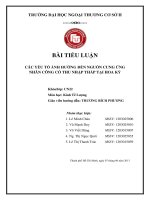Lan tỏa ngược ảnh hưởng bởi nguồn gốc khác nhau của FDI
Bạn đang xem bản rút gọn của tài liệu. Xem và tải ngay bản đầy đủ của tài liệu tại đây (1.69 MB, 30 trang )
<span class='text_page_counter'>(1)</span><div class='page_container' data-page=1>
<b>Backward Spillover from Different FDI Origins: </b>
<b>The Role of Geographical Distance and </b>
<b>Technology Intensity of Input Consumption</b>
<b>Pham Thi Bich Ngoc</b>
<i><b>Hoa Sen University, HCMC</b></i>
Pham Thi Bich Ngoc - Hoa Sen University 1
<b>APPLIED ECONOMICS</b>
<i><b>University of Economics Ho Chi Minh City</b></i>
</div>
<span class='text_page_counter'>(2)</span><div class='page_container' data-page=2>
<b>FOREIGN DIRECT INVESTMENT? (OECD, IMF)</b>
<b>FDI reflects </b><i><b>the objective of establishing a lasting interest</b></i> <b>by a </b>
<b>resident enterprise in one economy (direct investor) in an </b>
<b>enterprise (direct investment enterprise) that is resident in an </b>
<b>other economy, in which:</b>
<i><b>The</b></i> <i><b>foreign investor</b></i> <i><b>owns 10% or more</b></i> <i><b>of the ordinary shares or </b></i>
<i><b>voting power for an incorporated enterprise or</b></i> <i><b>an unincorporated </b></i>
<i><b>enterprise in which the</b></i> <i><b>foreign investor</b></i> <i><b>has equivalent ownership.</b></i>
<i><b>Direct Investment: </b></i><b>Equity capital/ Reinvested earnings/ </b>
<b>Acquisition of intangible assets</b>
<i><b>FDI modes: </b></i> <b>Greenfield vs. M&A</b>
</div>
<span class='text_page_counter'>(3)</span><div class='page_container' data-page=3>
<b>TYPES OF AFFILIATES AND THE EFFECTS:</b>
<b>0%</b>
<b><sub>10%</sub></b>
<b><sub>50%</sub></b>
<b><sub>100%</sub></b>
<b>Direct Investment</b>
<b>Voting </b>
<b>Power:</b>
<b>Associates</b> <b>Subsidiaries</b>
<b>Effects </b>
<b>of FDI</b>
<b>Product market effects</b>
<b>Factor market effects</b>
</div>
<span class='text_page_counter'>(4)</span><div class='page_container' data-page=4>
/>
/>
/>
moi-lo-cho-nganh-cong-nghiep-phu-tro-201405191626025677ca33.chn
</div>
<span class='text_page_counter'>(5)</span><div class='page_container' data-page=5>
<b>Inflows of Foreign Direct Investment, </b>
<b>1980-2009 </b>
</div>
<span class='text_page_counter'>(6)</span><div class='page_container' data-page=6>
<b>Horizontal vs. Vertical FDI</b>
Two main types of FDI:
<b>Horizontal FDI</b>
when the affiliate replicates the
production process (that the parent firm undertakes in
its domestic facilities) elsewhere in the world.
<b>Vertical FDI</b>
when the production chain is broken up,
and parts of the production processes are transferred
to the affiliate location.
</div>
<span class='text_page_counter'>(7)</span><div class='page_container' data-page=7>
<b>Outward Foreign Direct Investment for Top </b>
<b>Countries, 2007-2009</b>
Source: UNCTAD, World Investment Report, 2010.
</div>
<span class='text_page_counter'>(8)</span><div class='page_container' data-page=8>
<b>The Firm’s Decision Regarding Foreign </b>
<b>Direct Investment</b>
<i>Proximity-concentration </i>
trade-off:
High trade costs associated with exporting create an
incentive to locate production near customers.
Increasing returns to scale in production create an
incentive to concentrate production in fewer locations.
</div>
<span class='text_page_counter'>(9)</span><div class='page_container' data-page=9>
<b>The Firm’s Decision Regarding Foreign </b>
<b>Direct Investment (cont.)</b>
Foreign
<b>outsourcing</b>
or
<b>offshoring</b>
occurs when a
firm contracts with an independent firm to produce
in the foreign location.
In addition to deciding the
<b>location </b>
of where to
produce, firms also face an
<b>internalization </b>
decision:
whether to keep production done by one firm or by
separate firms.
</div>
<span class='text_page_counter'>(10)</span><div class='page_container' data-page=10>
<b>HORIZONTAL VS. VERTICAL FDI</b>
<b>HORIZONTAL</b>
<b>BACKWARD</b>
<b>FORWARD</b>
<b>FOREIGN </b>
<b>FIRMS</b>
<b>in the same </b>
<b>industries </b>
<b>in downstream </b>
<b>industries </b>
<b>in upstream </b>
<b>industries </b>
<b>Foreign firms produce complements or substitutes </b>
<b>of the local firms’ products</b>
<b>Foreign firms use inputs from local </b>
<b>firms to create outputs </b>
<b>Foreign firms create and sell intermediate inputs</b>
<b>to local firms</b>
<b>LOCAL </b>
<b>FIRMS</b>
<b>VER</b>
<b>TIC</b>
</div>
<span class='text_page_counter'>(11)</span><div class='page_container' data-page=11>
<b>2. SPILLOVER EFFECT – THEORETICAL FRAMEWORK</b>
<b>Once a MNC has established a subsidiary, they are likely to bring along </b>
<b>more sophisticated technology, marketing and managerial practices which </b>
<b>are possibly spilled over to the domestic firms through the channels: </b>
<b>imitation, skills acquisition, competition and exports (Wang and </b>
<b>Blomstroem, 1992; Haacker, 1999; Aitken & Harrison, 1999). </b>
<b>FDI may raise productivity levels </b> <b>of domestic firms in the industries </b>
<b>which they enter by improving the allocation of resources in those </b>
<b>industries (Javorcik, 2004, Helpman, 1999). </b>
<b>In nature, spillovers from FDI are more likely to be vertical than horizontal/ </b>
<b>MNCs can use ways of protection</b> <b>such as intellectual property, trade </b>
<b>secrecy, paying higher wages to prevent labor turnover or locating in </b>
<b>countries or industries where domestic firms have limited imitative </b>
<b>capacities to begin with (Gorg and Greenaway, 2004; Javorcik, 2004).</b>
</div>
<span class='text_page_counter'>(12)</span><div class='page_container' data-page=12>
<b>SPILLOVERS THROUGH HORIZONTAL AND VERTICAL LINKAGES</b>
University of Kiel, Germany
<b>HORIZONTAL</b>
<b>(+/-)</b>
<b>BACKWARD</b>
<b>(+/-)</b>
<b>FORWARD</b>
<b>(+/-)</b>
<b>FOREIGN </b>
<b>FIRMS</b>
<b>LOCAL </b>
<b>FIRMS</b>
<b>- Knowledge transfer</b>
- <b>High requirement ,</b>
<b>- demand increase </b>
<b>motivation</b>
<b>New, improved, less </b>
<b>costly intermediate </b>
<b>inputs</b>
- <b>Demonstration effect</b>
- <b>Competition effect</b>
- <b>Labor mobility effect</b>
- <b>Market stealing effect</b>
</div>
<span class='text_page_counter'>(13)</span><div class='page_container' data-page=13>
<b>3. EMPIRICAL STUDIES</b>
<b>Authors</b> <b>H</b> <b>B</b> <b>F</b>
<i>Goerg & Greenaway, (2004),</i>
<i>(17 researches for developing </i>
<i>countries/ 15 for developed ones, </i>
<i>and 8 for transition ones, </i>
<i>1966-2000)</i>
<b>+</b>
<b>(20 cases)</b>
<b></b>
<b>-(5 cases)</b>
<i>Goerg & Greenaway, (2004),</i>
<i>(5 researches on vertical </i>
<i>spillovers, 1974-2000)</i>
<b>+</b>
<b>(3 cases)</b>
<b>+</b>
<b>(1 case)</b>
<i>Javorcik (2004)</i>
<i>(Lithuania, 1996-2000)</i>
<b>?</b> <b>+</b> <b>?</b>
<i>Bwalya (2006)</i>
<i>(Zambia, 1993-1995)</i>
<b>+</b> <b>-</b> <b>X</b>
<i>Kim, H. H. & Kim, J.D. (2010)</i>
<i>(Korea, 1990-2008)</i>
<b>+</b> <b>+</b> <b>?</b>
</div>
<span class='text_page_counter'>(14)</span><div class='page_container' data-page=14>
<b>EMPIRICAL STUDIES, VIETNAM</b>
H: horizontal; B: backward; F: forward
X: not researched; ?: not evidenced
<b>Researches</b> <b>Data</b> <b>Objects</b> <b>Dependent </b>
<b>variables</b>
<b>H</b> <b>B</b> <b>F</b>
Le, Q. H.
and
Pomfret, R.,
(2008)
Firm
GSO,
2000-04
Manufacturing Labor
productivity
<b>-</b> <b>+</b> <b>X</b>
Nguyen, N.
A. et al.
(2008)
Firm
GSO,
2000-05
Manufacturing
Service
Output <b></b>
<b>-+</b>
<b>+</b>
<b>?</b>
<b>+</b>
<b></b>
-Nguyen, D.
C. et al.
(2008)
Firm
WB,
2002-04
Manufacturing Revenue <b>-</b> <b>?</b> <b>+</b>
Nguyen, P.
L. (2008)
Firm
GSO,
2000-05
</div>
<span class='text_page_counter'>(15)</span><div class='page_container' data-page=15>
<b>-Backward Spillover</b>
MNEs play two roles to domestic firms:
(1) They typically produce more complex products, acting as a spur to
local suppliers to upgrade their own technology base (Rodríguez-Clare,
1996),
(2) Their increased demand for inputs induces employment and growth in
domestic upstream firms (Markusen and Venables, 1999).
Backward spillovers can work on condition that local suppliers have to
be technologically advanced to absorb knowledge spillovers and deal
with the demand for specialized inputs (Kwon and Chun, 2009).
Low level of local linkages could be due to the incapacity of local firms
to meet appropriate quality standards, and to compete with global
components prices (Athukorala and Menon, 1996; Hobday, 1996).
</div>
<span class='text_page_counter'>(16)</span><div class='page_container' data-page=16>
<b>FDI and The Role of Investors’ origins </b>
Development distance between two economies (Findlay,
1978 )
Technology gap between the host and home countries
(Glass and Saggi, 1998)
<b>Geographical distance between the host and home </b>
<b>countries (Rodrigues-Clare, 1996) </b>
<b>Sourcing countries in or out of the agreement </b>
<b>association (Regional preferential trade agreements) </b>
<b>(Javorcik and Spatareanu , 2011) </b>
backward spillovers from investors from EU (-), America
(+), and Asia(not significant) to the Romanian firms.
</div>
<span class='text_page_counter'>(17)</span><div class='page_container' data-page=17>
<b>HYPOTHESIS</b>
FDI from one source economy could be low-tech or high-tech intensive
due to their development level
FDI from origins that the investors demand more low-tech products
possibly bring higher potential of backward spillovers to local suppliers
</div>
<span class='text_page_counter'>(18)</span><div class='page_container' data-page=18>
<b>The paper’s novelty</b>
It does not stop at finding different backward productivity
spillovers by investors’ origins but go further by explaining why
and how this channel occurs:
- The role of geographical distance: we separate two groups
-near vs. far from Vietnam
- The role of technology intensity of MNEs’ Input Consumption:
we create a low-tech intensity indicator (LTI) for foreign
investment from one source country both in the same and
downstream sectors
Previous scholars: the difference between countries
>< My study: different behaviors and characteristics of
investors from developing and developed nations
Sample: 23 Vietnamese manufacturing sectors, 2007-2010.
114, 733 obserations.
</div>
<span class='text_page_counter'>(19)</span><div class='page_container' data-page=19>
<b>FDI in Vietnam - WHY?</b>
• Vietnam is one of the
top 6 destinations for
FDI in 2008-2010
(UNCTAD, 2008)
• FDI inflows increased
from $1.3 billion in 1991
to $19.9 billion in 2010
• Two peaks:
$10.16 billion in 1996
$71.73 billion in 2008 0
200
400
600
800
1000
1200
1400
1600
1800
0
10000
20000
30000
40000
50000
60000
70000
80000
19
91
19
92
19
93
19
94
19
95
19
96
19
97
1
9
9
8
19
99
20
00
20
01
20
02
20
03
20
04
20
05
20
06
2
0
0
7
20
08
20
09
20
10
Registered capital (Mill. USD)
Implementation capital (Mill. USD)
Number of projects
<b>AFTA</b>
<b>WTO</b>
<b>ASEAN</b>
</div>
<span class='text_page_counter'>(20)</span><div class='page_container' data-page=20>
<b>FDI by origin:</b>
• App. 70 countries and
territories invest in
manufacturing sectors
• Asian economies
account for the major part
of FDI inflows.
• A strong wave of FDI
from ASEAN, Europe,
Japan, and Taiwan in
2008.
ASEAN
11%
the US
4%
China
3%
Europe
8%
Japan
24%
South Korea
12%
Taiwan
24%
Multi
5% Others
9%
<b>The Investors' Shares in Manufacturing by </b>
<b>Nationality, 2007 - 2010</b>
</div>
<span class='text_page_counter'>(21)</span><div class='page_container' data-page=21>
𝐻𝑜𝑟𝑖𝑧𝑜𝑛𝑡𝑎𝑙<sub>𝑗𝑡</sub> = ∀𝑖∈𝑗𝐹𝑜𝑟𝑒𝑖𝑔𝑛𝑠ℎ𝑎𝑟𝑒𝑖𝑡 ∗ 𝑌𝑖𝑡
𝑌<sub>𝑖𝑡</sub>
∀𝑖∈𝑗
a<sub>jk -</sub> the proportion of sector <i>j</i>’s output supplied to sector <i>k</i>
<i>m –</i> Origins: Japan, Taiwan, South Korea, US, China, ASEAN, EU, Multi.
<b>MODEL AND ESTIMATION STRATEGY:</b>
𝑙𝑛 𝑌
<sub>𝑖𝑗𝑡</sub>
= 𝛼+𝛽
<sub>1 </sub>
𝑙𝑛 𝐾
<sub>𝑖𝑗𝑡</sub>
+𝛽
<sub>2 </sub>
𝑙𝑛 𝐿
<sub>𝑖𝑗𝑡</sub>
+𝛽
<sub>3 </sub>
𝑙𝑛𝑀
<sub>𝑖𝑗𝑡</sub>
+𝛽
<sub>4 </sub>
𝐻𝑜𝑟𝑖𝑧𝑜𝑛𝑡𝑎𝑙
<sub>𝑗𝑡</sub>
+𝛽
<sub>5 </sub>
𝐵𝑎𝑐𝑘𝑤𝑎𝑟𝑑
<sub>𝑚𝑗𝑡</sub>
+𝜀
<sub>𝑖𝑗𝑡</sub>
𝐵𝑎𝑐𝑘𝑤𝑎𝑟𝑑
<sub>𝑚𝑗𝑡</sub>=
𝑎
<sub>𝑗𝑘</sub>𝑘 𝑖𝑓 𝑘≠𝑗
𝐻𝑜𝑟𝑖𝑧𝑜𝑛𝑡𝑎𝑙
<sub>𝑚𝑘𝑡</sub>𝐻𝑜𝑟𝑖𝑧𝑜𝑛𝑡𝑎𝑙<sub>𝑚𝑗𝑡</sub> = ∀𝑖∈𝑗𝐹𝑜𝑟𝑒𝑖𝑔𝑛𝑠ℎ𝑎𝑟𝑒𝑖𝑡 ∗ 𝐷𝑚∗ 𝑌𝑖𝑚𝑡
𝑌<sub>𝑖𝑡</sub>
∀𝑖∈𝑗
where
</div>
<span class='text_page_counter'>(22)</span><div class='page_container' data-page=22>
<b>Low </b>
<b>Tech </b>
<b>High </b>
<b>Tech </b>
<b>1. </b> <b>X </b> <b>D15. Manufacture Of Food Products And Beverages </b>
<b>2. </b> <b>X </b> <b>D16. Manufacture Of Tobacco Products </b>
<b>3. </b> <b>X </b> <b>D17. Manufacture Of Textiles </b>
<b>4. </b> <b>X </b> <b>D18. Manufacture Of Wearing Apparel; Dressing And Dyeing Of Fur </b>
<b>5. </b> <b>X </b> <b>D19. Tanning And Dressing Of Leather ... </b>
<b>6. </b> <b>X </b> <b>D20. Manufacture Of Wood And Of Products Of Wood ... </b>
<b>7. </b> <b>X </b> <b>D21. Manufacture Of Paper And Paper Products </b>
<b>8. </b> <b>X </b> <b>D22. Publishing, Printing And Reproduction Of Recorded Media </b>
<b>9. </b> <b>X </b> <b>D23. Manufacture Of Coke, Refined Petroleum Products And Nuclear Fuel </b>
<b>10. </b> <b>X </b> <b>D24. Manufacture Of Chemicals And Chemical Products </b>
<b>11. </b> <b>X </b> <b>D25. Manufacture Of Rubber And Plastics Products </b>
<b>12. </b> <b>X </b> <b>D26. Manufacture Of Other Non?metallic Mineral Products </b>
<b>13. </b> <b>X </b> <b>D27. Manufacture Of Basic Metals </b>
<b>14. </b> <b>X </b> <b>D28. Manufacture Of Fabricated Metal Products ... </b>
<b>15. </b> <b>X </b> <b>D29. Manufacture Of Machinery And Equipment N.e.c. </b>
<b>16. </b> <b>X </b> <b>D30. Manufacture Of Office, Accounting And Computing Machinery </b>
<b>17. </b> <b>X </b> <b>D31. Manufacture Of Electrical Machinery And Apparatus N.e.c. </b>
<b>18. </b> <b>X </b> <b>D32. Manufacture Of Radio, Television And Communication Equipment And </b>
<b>19. </b> <b>X </b> <b>D33. Manufacture Of Medical, Precision And Optical Instruments ... </b>
<b>20. </b> <b>X </b> <b>D34. Manufacture Of Motor Vehicles, Trailers And Semi?trailers </b>
<b>21. </b> <b>X </b> <b>D35. Manufacture Of Other Transport Equipment </b>
<b>22. </b> <b>X </b> <b>D36. Manufacture Of Furniture; Manufacturing N.e.c. </b>
<b>23. </b> <b>X</b> <b>D37. Recycling </b>
<i>*Notes: Manufacturing industries classified according their global technological intensity (OECD, 1993)</i>
</div>
<span class='text_page_counter'>(23)</span><div class='page_container' data-page=23>
<b>Distribution of Horizontals and Backwards - Japan </b>
</div>
<span class='text_page_counter'>(24)</span><div class='page_container' data-page=24>
<b>Distribution of Horizontals and Backwards - China </b>
</div>
<span class='text_page_counter'>(25)</span><div class='page_container' data-page=25>
<b>Low-tech Intensity Indicator (LTI)</b>
<i><b>For backward linkages:</b></i>
• If j = 15 low-tech industries:
• If j = 8 high-tech industries:
• <b>If LTI > 100%: </b>the buyers from country or association <i><b>m </b></i>purchase more local low-tech
products.
• <b>If LTI<= 100%:</b> the buyers from country or association <i><b>m</b></i>purchase more local high-tech
products.
<i><b>For horizontal linkages: </b></i>
• <b>If LTI > 100%: </b>foreign affiliates from country or association <i><b>m </b>appear more in </i>low-tech
industries.
• <b>If LTI<= 100%:</b> foreign affiliates from country or association<i><b>m </b>appear more in high</i>-tech
industries.
𝐵<sub>𝑚_𝑙𝑜𝑤𝑡𝑒𝑐 ℎ</sub> = 𝐵𝑗 𝑚𝑗𝑡
15
𝐵<sub>𝑚_ℎ𝑖𝑔ℎ𝑡𝑒𝑐ℎ</sub> = 𝐵𝑗 𝑚𝑗𝑡
8
<b>LTI = 100* </b><i><b>B</b><b><sub>mt_lowtech</sub></b></i>
<b>/</b>
<i><b>B</b><b><sub>mt_hightech</sub></b></i><b>LTI = 100* </b><i><b>H</b><b><sub>mt_lowtech</sub></b></i>
<b>/</b>
<i><b>H</b><b><sub>mt_hightech</sub></b></i></div>
<span class='text_page_counter'>(26)</span><div class='page_container' data-page=26>
<b>Low-tech Intensity for Backwards and Horizontals</b>
<i><b>%</b></i>
<i><b>Backwards- LTI</b></i> <i><b></b></i>
<i><b>Horizontals-LTI</b></i>
<i>2007 </i> <i>2008</i> <i>2009</i> <i>2010</i> <i>Avr. </i> <i>Avr.</i>
The US 258.9 200.5 235.6 202.6 <b>224.4</b> <b>99.3</b>
ASEAN 268.2 194.2 190.6 183.2 <b>209.1</b> <b>108.9</b>
China 217.3 292.6 301.3 319.5 <b>282.7</b> <b>218.6</b>
Europe 201.8 193.8 192.5 158.9 <b>186.8</b> <b>83.2</b>
Japan 63.1 60.3 63.2 57.6 <b>61.1</b> <b>9.0</b>
South Korea 110.1 112.9 111.7 150.2 <b>121.3</b> <b>105.7</b>
Taiwan 242.3 241.3 232.4 242.5 <b>239.6</b> <b>192.9</b>
Multinationals 117.9 121.5 104.3 131.4 <b>118.8</b> <b>13.6</b>
</div>
<span class='text_page_counter'>(27)</span><div class='page_container' data-page=27>
<b>BACKWARD SPILLOVERS BY ORIGIN, 2007-2010</b>
<b>Variables</b>
<i><b>Dependent Var._ lnTFP</b></i>
<i>OLS </i> <i>FE (JVs+100%FIEs)</i> <i>FE </i> (100% FIEs)
Btaiwan 2.139*** (0.429) 1.866*** (0.315) 2.276*** (0.321)
Bchina 3.014*** (1.036) -1.901*** (0.714) -1.678** (0.740)
Bamerica 9.481*** (2.080) 2.565* (1.504) 4.230** (1.692)
Basean -6.802*** (1.422) -8.226*** (1.202) -8.510*** (1.135)
Beurope 2.677*** (0.701) 2.591*** (0.712) 1.221* (0.635)
Bsouthkorea 0.203 (0.882) 0.200 (0.350) -0.186 (0.363)
Bmulti -0.246 (0.371) 0.343 (0.325) 0.203 (0.326)
Bjapan 1.356*** (0.350) -0.402*** (0.112) -0.323*** (0.108)
<i>Year dummies</i> <i>Y</i> <i>Y</i> <i>Y</i>
<i>Observations</i> <i>114,733</i> <i>114,733</i> <i>114,733</i>
<i>R-squared</i> <i>0.076</i> <i>0.085</i> <i>0.086</i>
<i><b>F_tests (P_ values):</b></i> <b>0.000</b> (Btaiwan=0, Basean=0, Beurope=0, Bjapan=0), <b>0.007</b>
(Bchina=0), <b>0.088</b> (Bamerica=0), <b>0.568</b> (Bsouthkorea=0), <b>0.291</b> (Bmulti=0).
</div>
<span class='text_page_counter'>(28)</span><div class='page_container' data-page=28></div>
<span class='text_page_counter'>(29)</span><div class='page_container' data-page=29>
<b>The Relation between Backward Spillover and LTI</b>
-10
-8
-6
-4
-2
0
2
4
0 1 2 3
<i><b>All foreign firms by origin </b></i>
-10
-8
-6
-4
-2
0
2
4
6
0 1 2 3
<i><b>Wholly foreign firms by origin</b></i>
TW
MU
MU JP SK
EU
US
TW
CN
ASEAN
JP SK
EU US
CN
ASEAN
</div>
<span class='text_page_counter'>(30)</span><div class='page_container' data-page=30>
Investments from one origin and their demand have
specific characteristics: low-tech or high-tech intensive.
The origins of which foreign firms demand more low-tech
products possibly bring higher backward spillovers to
domestic suppliers.
Lower backward spillovers from FDI originating from
countries which are located nearby Vietnam due to high
potential of imports.
Local high-tech manufacturers should promote
themselves to meet the demand from FDI customers.
<b>CONCLUSION:</b>
</div>
<!--links-->
<a href=' /><a href=' /><a href=' 201405191626025677ca33.chn'> </a>
ĐA DẠNG DI TRUYỀN DỰA TRÊN ĐẶC ĐIỂM HÌNH THÁI CỦA CÁC MẪU GIỐNG LÚA CÓ NGUỒN GỐC KHÁC NHAU
- 9
- 1
- 0








